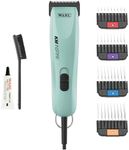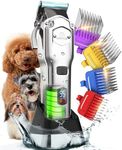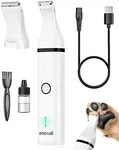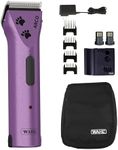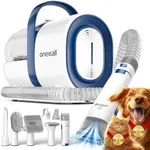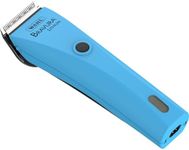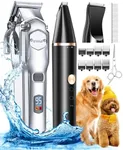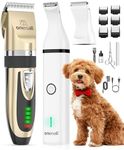Buying Guide for the Best Dog Grooming Clippers
Choosing the right dog-grooming clippers can make a big difference in your pet's grooming experience. The right clippers will help you keep your dog's coat neat and healthy, while also making the process easier and more comfortable for both you and your pet. When shopping for clippers, it's important to consider your dog's coat type, size, and temperament, as well as your own experience level. Understanding the key features of dog-grooming clippers will help you make a choice that fits your needs and ensures a safe, effective grooming session.Motor PowerMotor power refers to how strong and fast the clipper's motor is, which affects how easily it can cut through different types of fur. Stronger motors are better for thick, coarse, or matted coats, while lighter motors are suitable for fine or short hair. Motor power is often measured in strokes per minute (SPM) or by the type of motor (rotary, pivot, or magnetic). If your dog has a thick or double coat, look for higher power; for small breeds with fine hair, a lower power clipper will be sufficient and quieter, which can help keep nervous dogs calm.
Blade Type and MaterialThe blade is the part that actually cuts the hair, and its type and material affect both performance and maintenance. Blades can be made from stainless steel, ceramic, or carbon-coated materials. Stainless steel is durable and resists rust, while ceramic stays cooler during use. Some blades are detachable for easy cleaning and changing. If you plan to groom often or have multiple dogs, detachable and high-quality blades are a good choice. For occasional use or single-dog households, fixed blades may be enough.
Corded vs. CordlessClippers come in both corded and cordless versions. Corded clippers provide consistent power and are ideal for longer grooming sessions, but they require access to an outlet and can be less maneuverable. Cordless clippers offer more flexibility and are easier to use around a squirmy dog, but they rely on battery life, which can limit use time. If you need to groom for long periods or have a large dog, corded may be better; for quick touch-ups or portability, cordless is more convenient.
Noise and Vibration LevelThe amount of noise and vibration a clipper makes can affect your dog's comfort. Some dogs are sensitive to loud or vibrating tools, which can make grooming stressful. Quieter, low-vibration clippers are better for nervous or small dogs, while noise may be less of an issue for calm or larger breeds. If your dog is anxious, look for clippers specifically designed to be quiet and smooth.
Weight and ErgonomicsThe weight and shape of the clippers affect how comfortable they are to hold and use, especially during longer grooming sessions. Lightweight, ergonomically designed clippers reduce hand fatigue and make it easier to maneuver around your dog's body. If you have a large dog or plan to groom frequently, prioritize comfort and ease of handling. For occasional use, this may be less critical, but still important for a pleasant experience.
Adjustable Cutting LengthsMany clippers offer adjustable blades or come with guide combs to control how much hair is cut. This allows you to choose different hair lengths for different parts of your dog's body. If you want versatility or plan to try different styles, look for clippers with multiple length settings or attachments. For simple trims, a single length may be enough.
Ease of Cleaning and MaintenanceKeeping your clippers clean is important for hygiene and performance. Some clippers have detachable blades or are designed to be easy to clean and oil. If you want low-maintenance grooming, look for models that are simple to take apart and clean. Regular cleaning will also help your clippers last longer and work better.

